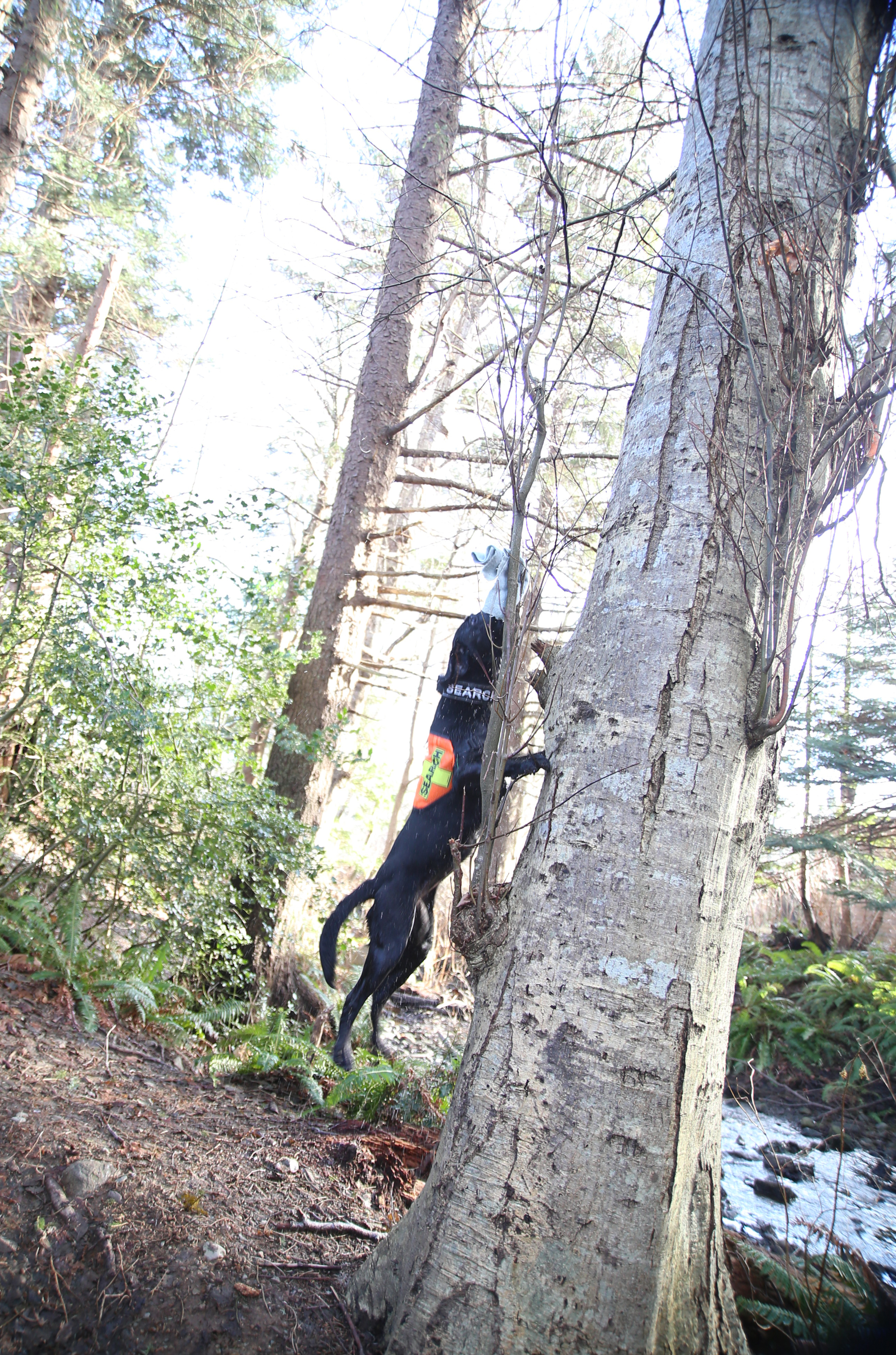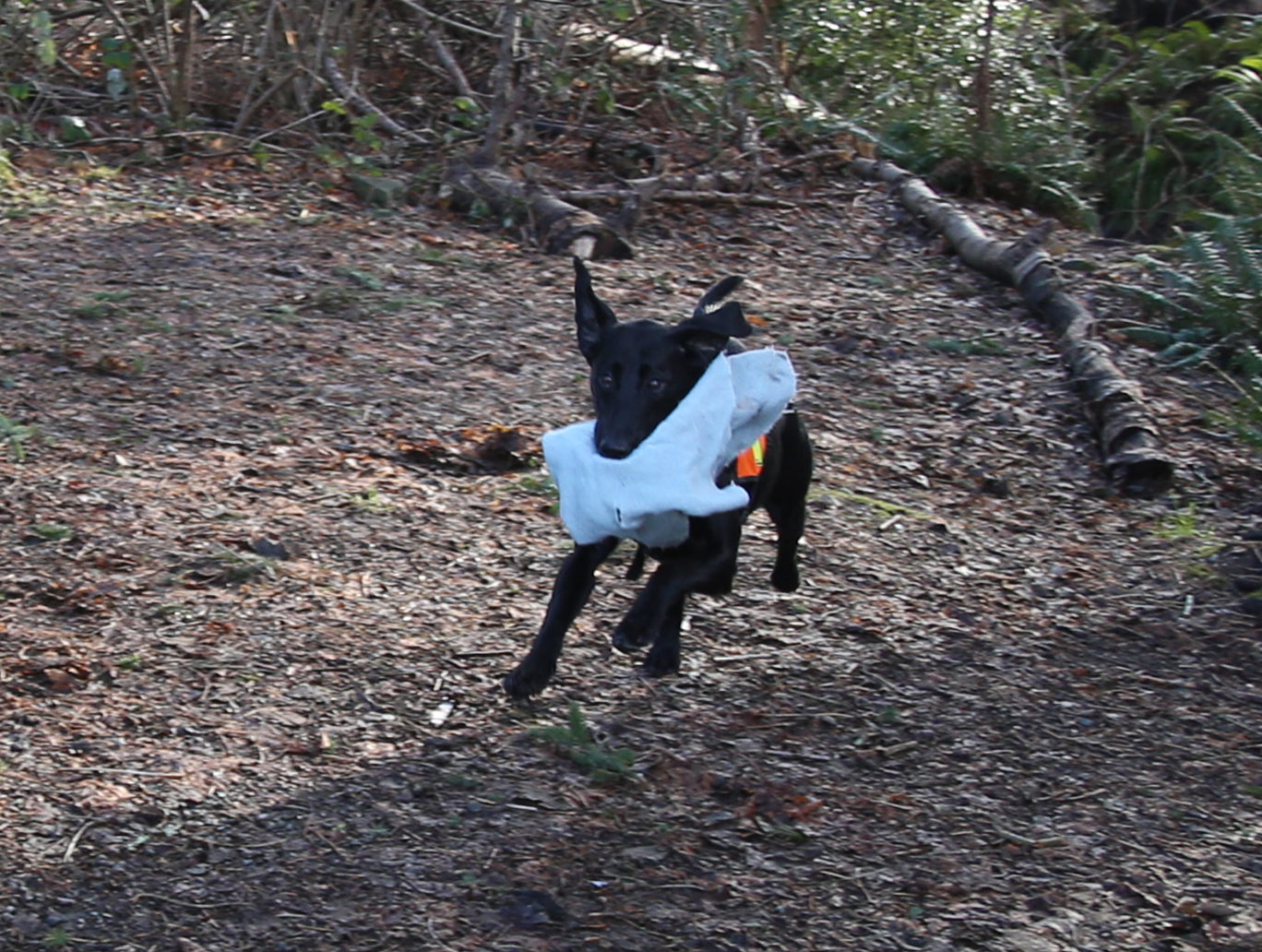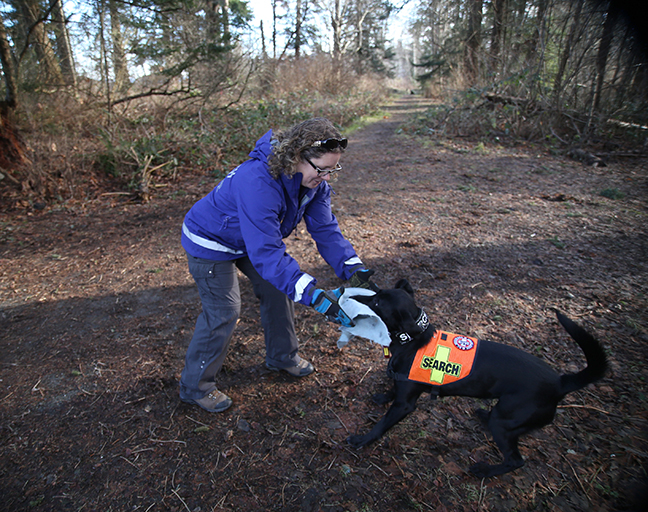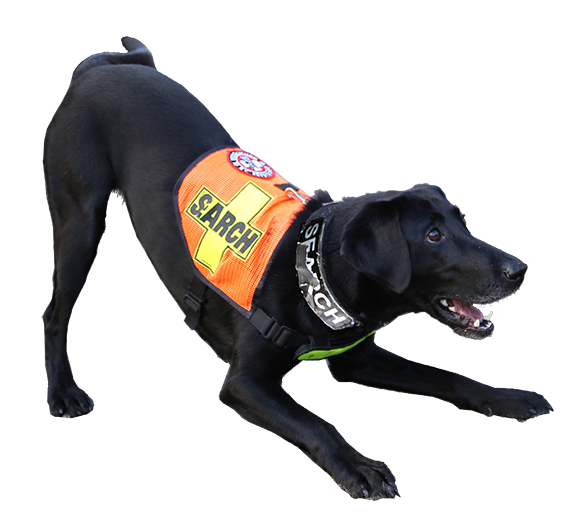In the months following hurricane Katrina, Natasha Provost volunteered to travel south and join in the animal relief efforts. At the time she was working as a veterinary assistant.
“I got tasked to go help the disaster dogs, which are the dogs, and the cadaver dogs, that go and look for the bodies,” she says. “I got to look after them when they came in. We would scrub them down because there were so many contaminates, and look after them and make sure they were healthy enough to go out again.”
It was during that trip that Provost became interested in becoming a rescue dog handler.
The first course she took was geared towards disaster work, but because she had a young son she knew she couldn’t fly all over the world with a rescue dog at the last minute, so she took a clinic with the BC Search Dog Association and joined Campbell River Search and Rescue.
Daryl Beck and his dog Keeva and Provost and her dog Spirit are two of three air scenting search dog teams on Vancouver Island. Both are based in Campbell River.
They are tested and certified annually to work as search and rescue K-9 teams and Beck and Provost train all the time. When the dogs have their collars and vests on they know they are supposed to be working.
When they arrive on the scene, whether it be by boat or by helicopter when necessary, they are assigned a section of land to search and it is their job to clear that section by either finding evidence of the missing person and continuing the search in that area or not and moving on to somewhere else.
Just because there is a dog on the scene, that doesn’t mean the search is over, Beck says.
“I am just one more part
of our search organization.”
Dogs take the place of manpower. Beck figures a team of two with a dog can search the same area as a group of 10 people.
Keeva and Spirit look for things in the bush that don’t belong, such as a person or an article of clothing. A major part of their training is that they know if the team is travelling in a specific direction, that is where they are supposed to be searching.
“We don’t follow the dog, the dog follows our pattern,” Beck says.
That being said, just because a family pet can play hide and seek or find their ball in the trees or water, doesn’t mean they are cut out to be a search and rescue dog.
“I think the big difference…is that our dogs are trained to search in a systematic way and ignore things that aren’t part of the search profile,” Beck says.
Provost got Spirit specifically to be a search and rescue dog. The first puppy she brought home didn’t have the motivation to do the job, so Provost returned her to the breeder to be re-homed.
“It was a very very hard and emotional decision, after all the time and money that you put in to training,” she says. “But if my child was out there lost I know I would want a dog that I know was going to work.”
Beck had a similar experience. He has two dogs of the same breed, Keeva is an amazing search dog and the other is better just as a family pet.

That being said, both Spirit and Keeva are pets. They just have a job to do once they don their collar.
The dogs aren’t the only ones who need to be certified. The annual test marks the handlers skills just as much as the dogs. The first time Provost tried to get Spirit certified the dog was ready but Provost was not.
“We got failed because I made the mistake,” she says.
The test course is a 500 metre by 500 metre section of bush where things are planted for the dogs to find. The team has to search for at least an hour and a half to demonstrate their skills. The first time around Spirit found every article in the areas that Provost directed her to, but Provost wasn’t trusting her own skills with the compass and she made her search grid too narrow.
After lots of practice she got a handle on it and she has been certified for three years, with her next test coming up this month. So far they have been out on 12 searches, most recently on Denman Island.
For Beck, getting certified was bittersweet.
“As soon as I was validated that meant I could go on a search and wow, huge pressure,” he said.
When he is out in the field he is always anxious to learn where the person was found in the end, and if it was in or near one of his search areas.
He had one close call, where, even though the person wasn’t found in his search area, it was close enough that he felt he and Keeva should have found them.
“That one will always stay with me,” he says.
He had to debrief with a friend who reminded him that no-one is perfect and that there were other people as well as police dogs on scene.
Keeva and Spirit are air scenting dogs. They don’t follow scent on the ground, they look for things that are out of place in the bush. Because of that it is better for them to search when it is cooler out, because as the temperature drops the scent drops closer to the ground as well, Beck says.
So if they have a choice of areas they are going to search they might wait for the day to cool off or they might choose a more shaded area.
Provost and Beck have also learned to use the wind and read the geography to better utilize their dogs’ noses. When tackling a field they work their way into the wind. If there is a ditch or a ravine they send the dogs to the bottom instead of just walking along the edge. Part of their search and rescue training is to consider what a person lost in the woods would do, so they will send their dogs over to a grove of trees that might seem like a safe place to hunker down.
The dogs sometimes have to work for hours and hours on end, but one of the most important parts is ensuring their safety and making sure they can still actually do their job. Spirit cut her paw on a search once, and that was the end of the day for her.
“If they aren’t acting like themselves you have to make the decision, is this going to affect the search and if it is, you say no we are done we have to stop,” Provost says.
Keeva, at nine years old is nearing the end of her search and rescue career. Beck said this is probably her last year before a kushy retirement as only a house pet.
Provost and Spirit are just getting started. Puppies can first be certified at 1.5 years old and some work in the field until they are nine or ten years old. Beck calls Spirit a very high achiever.
“Her energy is above and beyond any other search dog,” Provost says. “She is kind of the clown.”
Search dogs can work in areas where other searchers have been, and they can work with other search resources. Using scent articles, they can discriminate for the missing person in heavily populated areas. They can work day or night, in most kinds of weather, and are especially effective where human sight
is most limited — in the dark, in dense woods or heavy brush, in debris (as found in earthquakes, floods, and tornadoes) and under water.
